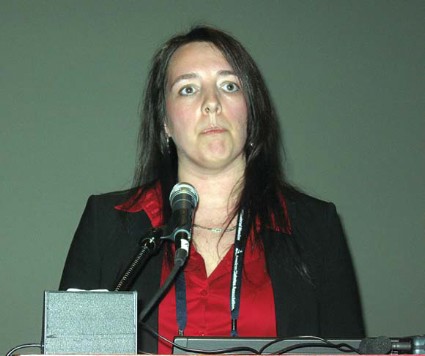User login
CHICAGO – Dapagliflozin and glipizide achieve comparable hemoglobin A1c reduction as add-on therapy in patients with type 2 diabetes inadequately controlled on metformin, but investigational dapagliflozin is only one-tenth as likely to produce hypoglycemia and is far more impressive in terms of weight reduction.
Those were the key findings of a 52-week, double-blind, randomized phase III trial in 814 patients who remained on their metformin following randomization to dapagliflozin at up to 10 mg/day or glipizide at up to 20 mg/day, Dr. Katja Rohwedder reported at the annual scientific sessions of the American Diabetes Association.
Dapagliflozin is a member of the emerging new class of oral antidiabetic drugs known as sodium glucose cotransporter–2 (SGLT2) inhibitors. Their novel mechanism of reducing hyperglycemia involves boosting urinary glucose excretion without affecting insulin secretion or action. Dapagliflozin was the first-in-class SGLT2 inhibitor to emerge from the developmental pipeline and seek regulatory approval. While it has been approved by the European Medicines Agency and is marketed as Forxiga in Europe for the treatment of type 2 diabetes, the Food and Drug Administration rejected the drug pending receipt of additional data to clarify an observed possible small excess of cases of breast and bladder cancer in the clinical trials. Following that action, the FDA proceeded to approve canagliflozin (Invokana) as the first SGLT2 inhibitor in the United States.
Dr. Rohwedder reported that 74.7% of the dapagliflozin group and a closely similar 73.8% of the glipizide group in the phase III add-on trial achieved an HbA1c reduction at 52 weeks. Weight reduction was a different story, however: it was achieved in 83.5% of the dapagliflozin group, compared with 26.8% with glipizide.
The combination of HbA1c and weight reduction occurred in 67% of the dapagliflozin group, a rate more than threefold greater than the 21% figure in the glipizide arm of the study, according to Dr. Rohwedder of AstraZeneca in Wedel, Germany
A second analysis utilized a more rigorous combined endpoint requiring at least a 0.5% reduction in HbA1c level and a weight loss of 3 kg or more at 52 weeks. This was achieved in one-third of the add-on dapagliflozin group, compared with less than 4% of patients on the add-on glipizide.
"I hope you will agree that this is meaningful to our patients," she said.
Hypoglycemic events occurred in 3.5% of the dapagliflozin group, compared with 40.8% with glipizide. All three serious cases involved patients on glipizide.
Genital infections occurred in 10.8% of patients on dapagliflozin and 1.7% of those on glipizide. Urinary tract infections were also more frequent with SGLT2 inhibitor therapy, by a margin of 8.6% to 5.4%.
"These events responded well to standard therapy and only rarely led to study discontinuation," according to the physician.
Session chair Dr. Ralph A. DeFronzo commented that "this study shows a pretty clear-cut distinction between these two oral agents in terms of weight gain, an important side effect that we’re all concerned about in the diabetes field."
No cases of breast or bladder cancer were reported in this 52-week study.
The time may be here "to get rid of the sulfonylureas and go to drugs that really work, without causing safety issues," suggested Dr. DeFronzo, professor of medicine and chief of the diabetes division at the University of Texas Health Science Center at San Antonio.
The phase III study was supported by Bristol-Myers Squibb and AstraZeneca, which are jointly developing dapagliflozin. Dr. Rohwedder is an employee of AstraZeneca.
CHICAGO – Dapagliflozin and glipizide achieve comparable hemoglobin A1c reduction as add-on therapy in patients with type 2 diabetes inadequately controlled on metformin, but investigational dapagliflozin is only one-tenth as likely to produce hypoglycemia and is far more impressive in terms of weight reduction.
Those were the key findings of a 52-week, double-blind, randomized phase III trial in 814 patients who remained on their metformin following randomization to dapagliflozin at up to 10 mg/day or glipizide at up to 20 mg/day, Dr. Katja Rohwedder reported at the annual scientific sessions of the American Diabetes Association.
Dapagliflozin is a member of the emerging new class of oral antidiabetic drugs known as sodium glucose cotransporter–2 (SGLT2) inhibitors. Their novel mechanism of reducing hyperglycemia involves boosting urinary glucose excretion without affecting insulin secretion or action. Dapagliflozin was the first-in-class SGLT2 inhibitor to emerge from the developmental pipeline and seek regulatory approval. While it has been approved by the European Medicines Agency and is marketed as Forxiga in Europe for the treatment of type 2 diabetes, the Food and Drug Administration rejected the drug pending receipt of additional data to clarify an observed possible small excess of cases of breast and bladder cancer in the clinical trials. Following that action, the FDA proceeded to approve canagliflozin (Invokana) as the first SGLT2 inhibitor in the United States.
Dr. Rohwedder reported that 74.7% of the dapagliflozin group and a closely similar 73.8% of the glipizide group in the phase III add-on trial achieved an HbA1c reduction at 52 weeks. Weight reduction was a different story, however: it was achieved in 83.5% of the dapagliflozin group, compared with 26.8% with glipizide.
The combination of HbA1c and weight reduction occurred in 67% of the dapagliflozin group, a rate more than threefold greater than the 21% figure in the glipizide arm of the study, according to Dr. Rohwedder of AstraZeneca in Wedel, Germany
A second analysis utilized a more rigorous combined endpoint requiring at least a 0.5% reduction in HbA1c level and a weight loss of 3 kg or more at 52 weeks. This was achieved in one-third of the add-on dapagliflozin group, compared with less than 4% of patients on the add-on glipizide.
"I hope you will agree that this is meaningful to our patients," she said.
Hypoglycemic events occurred in 3.5% of the dapagliflozin group, compared with 40.8% with glipizide. All three serious cases involved patients on glipizide.
Genital infections occurred in 10.8% of patients on dapagliflozin and 1.7% of those on glipizide. Urinary tract infections were also more frequent with SGLT2 inhibitor therapy, by a margin of 8.6% to 5.4%.
"These events responded well to standard therapy and only rarely led to study discontinuation," according to the physician.
Session chair Dr. Ralph A. DeFronzo commented that "this study shows a pretty clear-cut distinction between these two oral agents in terms of weight gain, an important side effect that we’re all concerned about in the diabetes field."
No cases of breast or bladder cancer were reported in this 52-week study.
The time may be here "to get rid of the sulfonylureas and go to drugs that really work, without causing safety issues," suggested Dr. DeFronzo, professor of medicine and chief of the diabetes division at the University of Texas Health Science Center at San Antonio.
The phase III study was supported by Bristol-Myers Squibb and AstraZeneca, which are jointly developing dapagliflozin. Dr. Rohwedder is an employee of AstraZeneca.
CHICAGO – Dapagliflozin and glipizide achieve comparable hemoglobin A1c reduction as add-on therapy in patients with type 2 diabetes inadequately controlled on metformin, but investigational dapagliflozin is only one-tenth as likely to produce hypoglycemia and is far more impressive in terms of weight reduction.
Those were the key findings of a 52-week, double-blind, randomized phase III trial in 814 patients who remained on their metformin following randomization to dapagliflozin at up to 10 mg/day or glipizide at up to 20 mg/day, Dr. Katja Rohwedder reported at the annual scientific sessions of the American Diabetes Association.
Dapagliflozin is a member of the emerging new class of oral antidiabetic drugs known as sodium glucose cotransporter–2 (SGLT2) inhibitors. Their novel mechanism of reducing hyperglycemia involves boosting urinary glucose excretion without affecting insulin secretion or action. Dapagliflozin was the first-in-class SGLT2 inhibitor to emerge from the developmental pipeline and seek regulatory approval. While it has been approved by the European Medicines Agency and is marketed as Forxiga in Europe for the treatment of type 2 diabetes, the Food and Drug Administration rejected the drug pending receipt of additional data to clarify an observed possible small excess of cases of breast and bladder cancer in the clinical trials. Following that action, the FDA proceeded to approve canagliflozin (Invokana) as the first SGLT2 inhibitor in the United States.
Dr. Rohwedder reported that 74.7% of the dapagliflozin group and a closely similar 73.8% of the glipizide group in the phase III add-on trial achieved an HbA1c reduction at 52 weeks. Weight reduction was a different story, however: it was achieved in 83.5% of the dapagliflozin group, compared with 26.8% with glipizide.
The combination of HbA1c and weight reduction occurred in 67% of the dapagliflozin group, a rate more than threefold greater than the 21% figure in the glipizide arm of the study, according to Dr. Rohwedder of AstraZeneca in Wedel, Germany
A second analysis utilized a more rigorous combined endpoint requiring at least a 0.5% reduction in HbA1c level and a weight loss of 3 kg or more at 52 weeks. This was achieved in one-third of the add-on dapagliflozin group, compared with less than 4% of patients on the add-on glipizide.
"I hope you will agree that this is meaningful to our patients," she said.
Hypoglycemic events occurred in 3.5% of the dapagliflozin group, compared with 40.8% with glipizide. All three serious cases involved patients on glipizide.
Genital infections occurred in 10.8% of patients on dapagliflozin and 1.7% of those on glipizide. Urinary tract infections were also more frequent with SGLT2 inhibitor therapy, by a margin of 8.6% to 5.4%.
"These events responded well to standard therapy and only rarely led to study discontinuation," according to the physician.
Session chair Dr. Ralph A. DeFronzo commented that "this study shows a pretty clear-cut distinction between these two oral agents in terms of weight gain, an important side effect that we’re all concerned about in the diabetes field."
No cases of breast or bladder cancer were reported in this 52-week study.
The time may be here "to get rid of the sulfonylureas and go to drugs that really work, without causing safety issues," suggested Dr. DeFronzo, professor of medicine and chief of the diabetes division at the University of Texas Health Science Center at San Antonio.
The phase III study was supported by Bristol-Myers Squibb and AstraZeneca, which are jointly developing dapagliflozin. Dr. Rohwedder is an employee of AstraZeneca.
AT THE ADA ANNUAL SCIENTIFIC SESSIONS
Major Finding: At week 52, 67% of type 2 diabetes patients on dapagliflozin had reductions in both HbA1c and weight, compared with 21% on glipizide.
Data Source: A phase III, double-blind, 52-week randomized trial of the add-on dapagliflozin or glipizide in 814 patients with type 2 diabetes not adequately controlled with metformin.
Disclosures: The phase III study was supported by Bristol-Myers Squibb and AstraZeneca, which are jointly developing dapagliflozin. Dr. Rohwedder is an employee of AstraZeneca.

